“Empires were not built in a day, nor homes in an hour.” —E. A. Bucchianeri
This is a complete breakdown of the Canva marketing strategy that helped the brand grow to a $6 billion valuation, generate 20 million monthly active users, and gain customers across 190 countries—including 85% of all Fortune 500 brands.
Like a great Empire – Canva hasn’t achieved this success overnight. It’s taken years of smart decisions, brilliant execution and prolific vision to build their brand.
We’ll be diving deep into the marketing tactics that have helped them acquire 4+ million backlinks and over 270 million visitors a year. This is not just a guide to understanding how Canva dominated the SERP. It’s a masterclass on how to create a content marketing empire that drives real results using an inbound marketing funnel.
In this essay you’re going to learn:
- How to create content for user intent
- The role of content directories for SEO
- How to create scalable landing pages
- How to create a scalable backlink program
- The role of responding to current trends for products
- How to reach thousands of people through your blog
- An opportunity that even Canva has overlooked
So if you want to scale up your content, get more traffic and create a content marketing engine that runs as smooth as butter, you’re going to love today’s essay. This is the story of how Canva was able to create a backlink empire. Let’s get started.
Using Search Intent To Inspire Landing Pages
Canva has two key landing pages for most of their use cases:
A page for discovery and a page for creation.
Check out the examples below. On the left, we have a page for people who want to design a certificate, and on the right we have a landing page for people looking for certificate templates. Both types of searchers are trying to find a solution like Canva, but the way they view their problem is different.
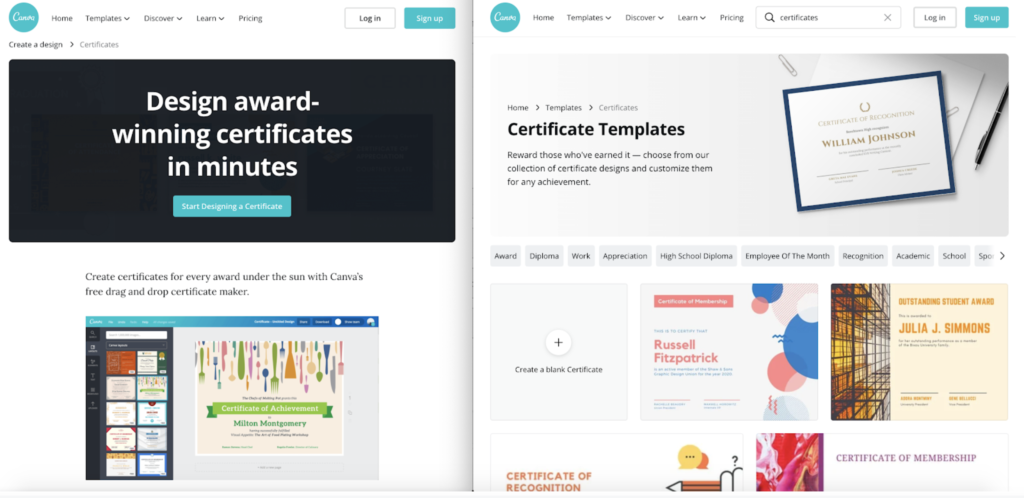
The landing page on the left, which is ranking for phrases like “design certificates” and “create certificates,” gets 16,000 visits a month. The landing page on the right, which ranks for phrases like “certificate template” and “free certificate template,” generates 33,000 hits a month. Both of these landing pages have a role to play in Canva’s SEO strategy, which we’ll dive into throughout this essay.
But at the core, Canva’s success with these landing pages comes down to a few fundamental ideas:
- Understanding the intent of the person using Google
- Develop a parent and child relationship for other landing pages
- Create a scalable landing page structure
- An investment in backlink outreach
- Creating a strong content culture
Understand the intent of the person using Google
Search intent is a fundamental part of SEO, but it’s often overlooked by marketers and content creators. Most SEOs only focus on keyword volume when they should be thinking about the intent behind those keywords. Search intent is the goal a person has when they type a query into a search engine.
There are four key types of online search intent:
- Informational: Looking for information (e.g., “who is Prince?”)
- Navigational: Looking to get somewhere specific (e.g., “Canva blog”)
- Transactional: Looking for an asset to buy, use or download (e.g., “create invitation”)
- Investigational: Trying to compare assets (e.g., “Canva vs. Adobe Spark”)
Let’s revisit those two landing pages from Canva. Both appeal to transactional intent, but one landing page attracts those who want to do something (“create certificates”) while the other attracts those who want to discover something (“free certificate template”).
Using terms from Canva’s site architecture, we’ll call these two types “Create Pages” and “Template Pages.”
Create Pages: Use Case – Certificates
Title: Free online certificate maker: create custom designs online
Top Keywords: certificate maker, create certificate, make your own certificate
Volume: 16,000 / month
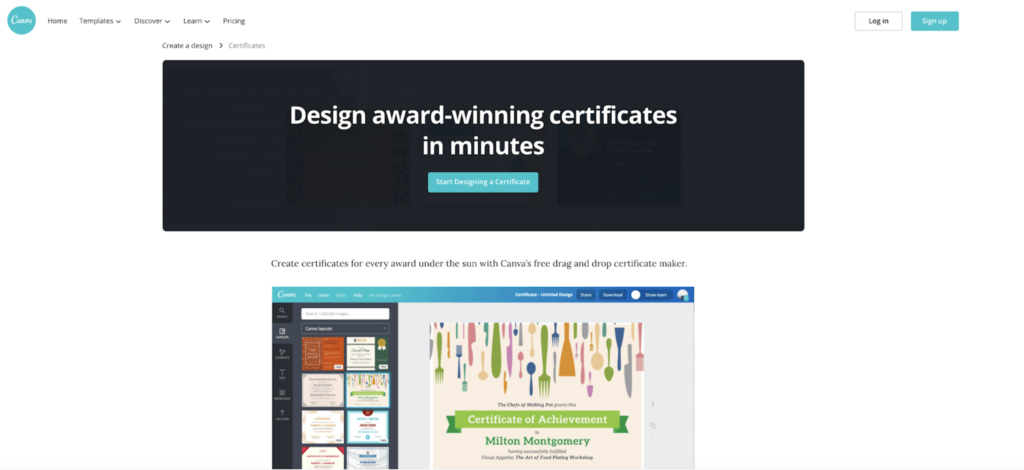
Template Pages: Use Case – Certificates
Title: Customize 1,649+ certificates templates online
Top Keywords: certificate template, free certificate template, award certificate template
Volume: 32,400 / month
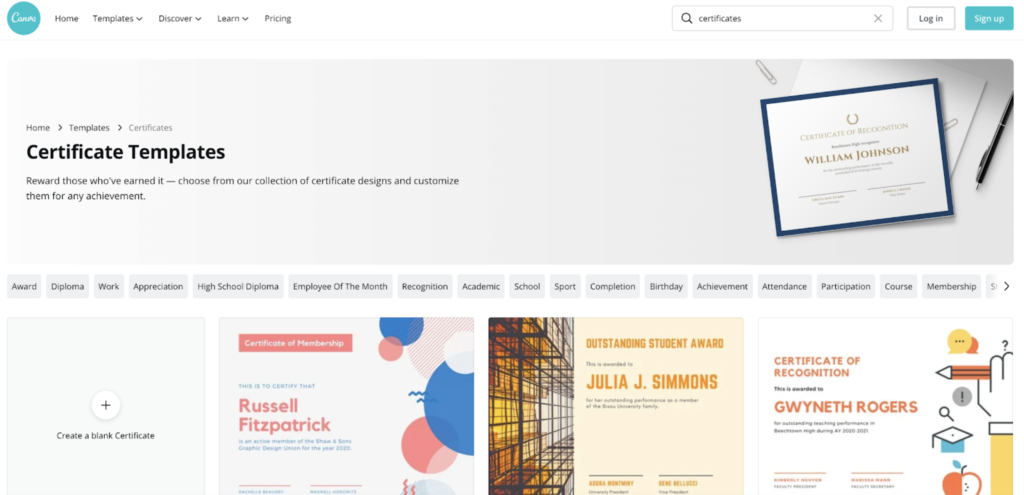
Landing Pages & A Directory For Niche Intent & Use Cases
One of the strategies that Canva has embraced to perfection is the use of content directories focused on different use cases and long tail keywords. The site architecture being used for both do (Create) and discover (Template) pages is a thing of beauty:
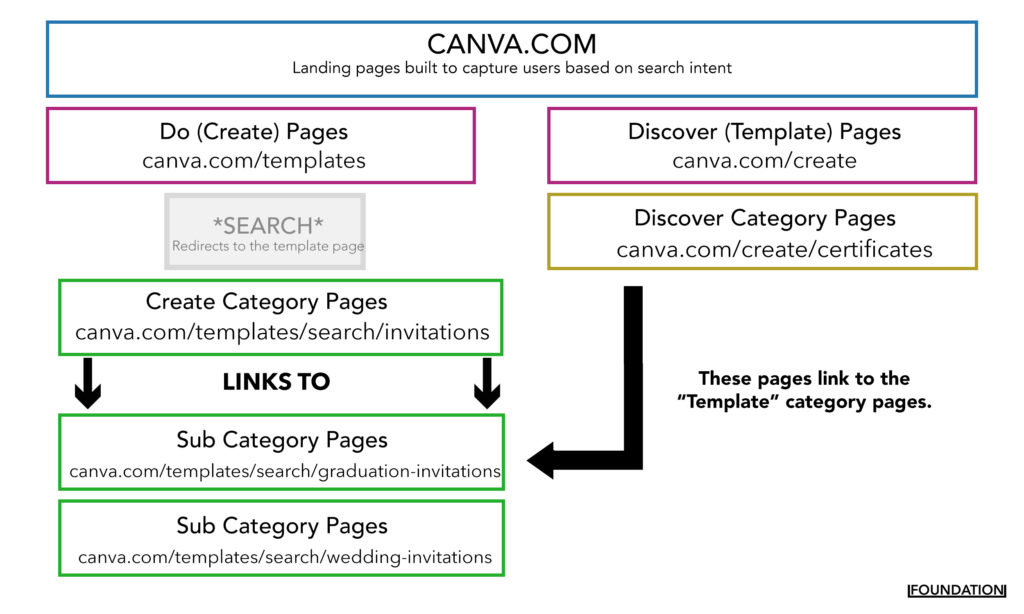
For example in the the do (create) pages for “invitations” the URL would be:
- Canva.com / templates / search / invitations / save-the-date
/ invitations is the asset and / save-the-date is the niche-asset
For the discover (template) pages for invitations the URL would be:
Canva.com / Create / Invitations
That URL would have a link that then drove back to various invitation templates like:
- Canva.com / templates / search / invitations / save-the-date
- Canva.com / templates / search / invitations / christmas
- Canva.com / templates / search / invitations / wedding
- Canva.com / templates / search / invitations / baby-shower
Across the entire site, we found that Canva has more than 55 parent pages, each with up to 78 child pages. For example, here’s a look at the parent and child relationship for landing pages focused on “Invitations” and the various keyword variations that make up child landing pages (aka niche types of invitations):
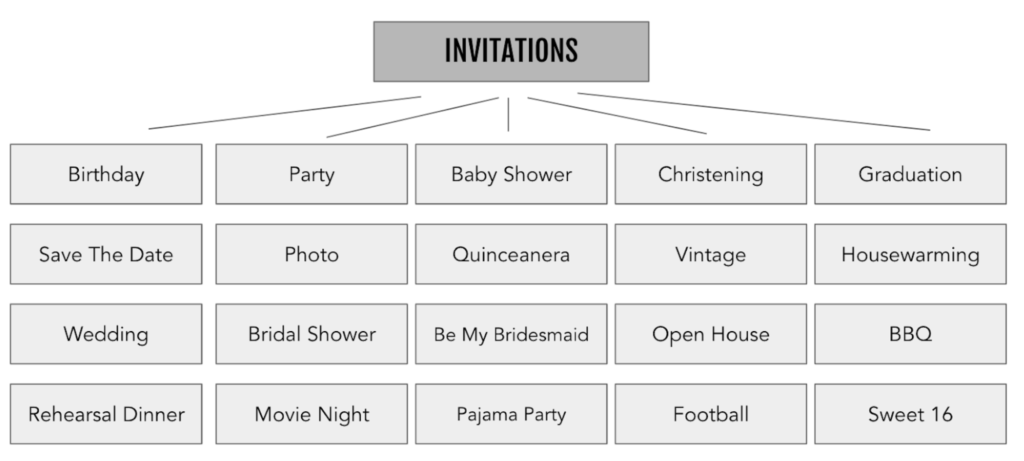
This isn’t even all of the child pages for invitations. There are 73 of them in total!
But each of these child pages has been able to capture quite a few backlinks and as a result generate a significant amount of traffic. The “Invitations” category alone has 900 backlinks and generates more than 65,000 organic visitors per month across the parent and child pages.
WHY BACKLINKS MATTER: Backlinks are valuable for SEO because they act as a vote of confidence from one site to another. Search engines track backlinks to determine the trustworthiness of your content—the more links your page can get from other trusted pages, the better that page will look to search engines. All resource metrics can be analyzed and monitored by a backlink management tool, which will show the authority of the domains, links types (dofollow or noffolow), website traffic, etc.
Here’s a snapshot of the distribution of backlinks across the “Invitations” child pages:
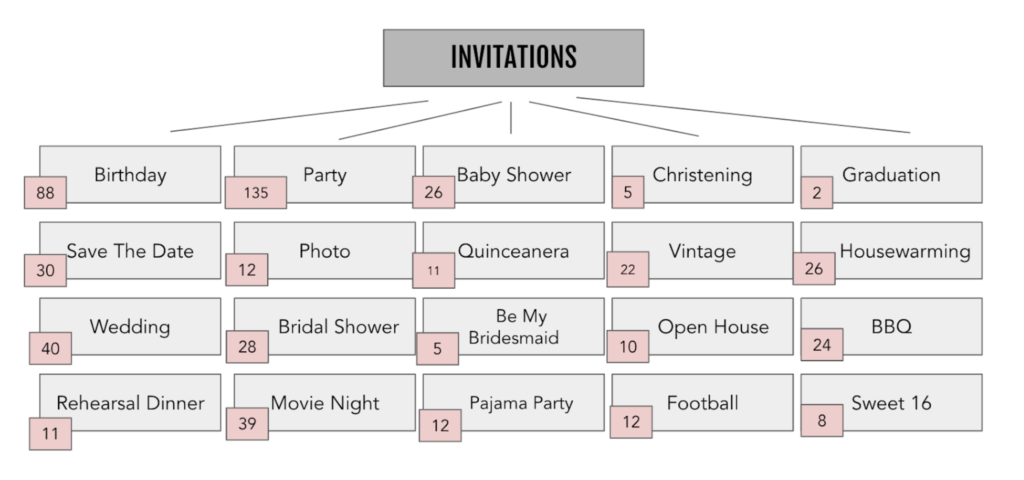
These child pages have links from The Next Web, Yahoo, Thrillist, The Spruce and more. These sites range in domain authority from 80 to 92—meaning they’re trusted by search engines and are unlikely to be filled with spam. In fact, some of the sites that compete directly with Canva for relevant keywords link to Canva’s child pages, lending additional credibility.
The anchor text associated with many of these links is a variation of “Free [Child Page] Invitation Templates from Canva.” This is as good as it gets for SEO purposes. Every backlink with this anchor text tells Google that this asset is the best template for creating movie night invitations, sweet 16 invitations or baby shower invitations.
Now apply this same approach across 57 parent pages (Coupons, Letterheads, Invoices, Flyers, Labels, Book Covers, Class Schedules, etc.) and more than 300 child pages that are essentially niche versions of their parent pages.
It’s an SEO dream come true:
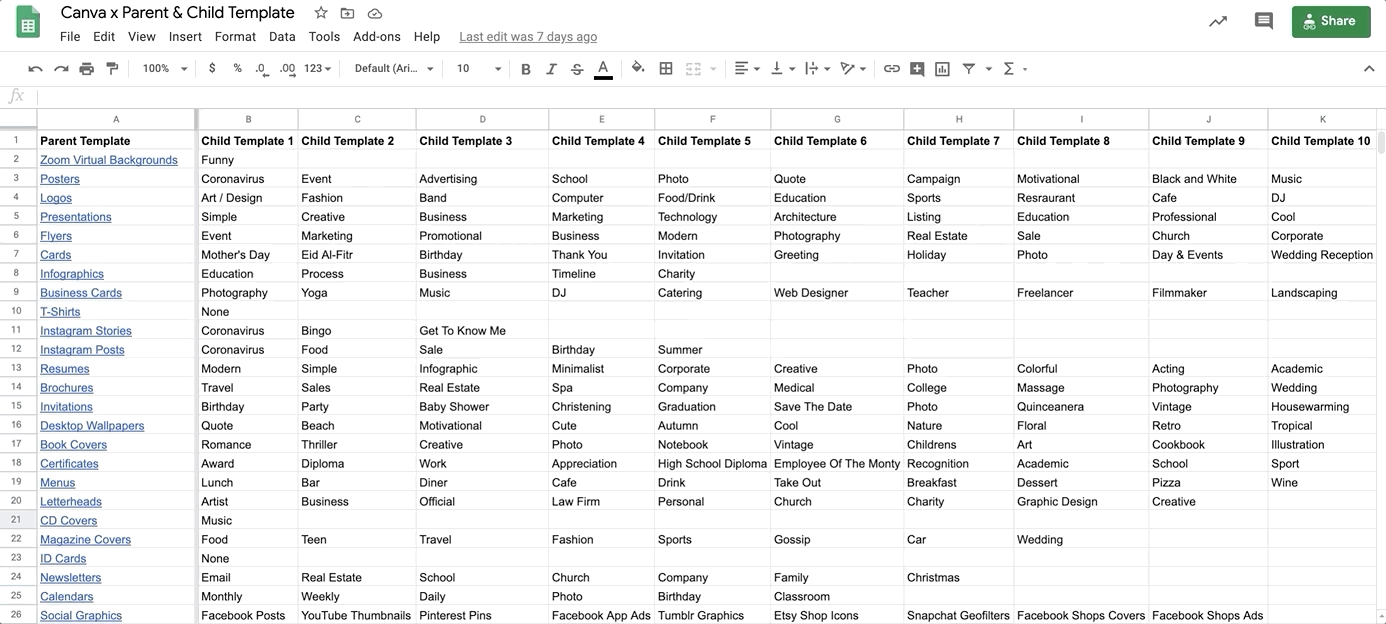
Want access to the entire spreadsheet? Click here to download.
All these landing pages compound the effects of Canva’s great internal linking, but they also allow the brand to rank for very niche / long tail keywords.
For example, it’s estimated that there are fewer than 15 searches a month for “create massage gift certificates.” But Canva has a landing page for just that keyword. Thanks to the strength of their existing backlinks and their authority in the “certificate” space, they’re able to capture even this small level of demand with a landing page that will rank for a long time.
Create Scalable Landing Pages That Rank & Convert
The “Create” landing pages for Canva aren’t just great for interlinking—they’re crafted in a way that easily scales. The pages follow a very standard template that is easy for a content creator to replicate for multiple child pages:
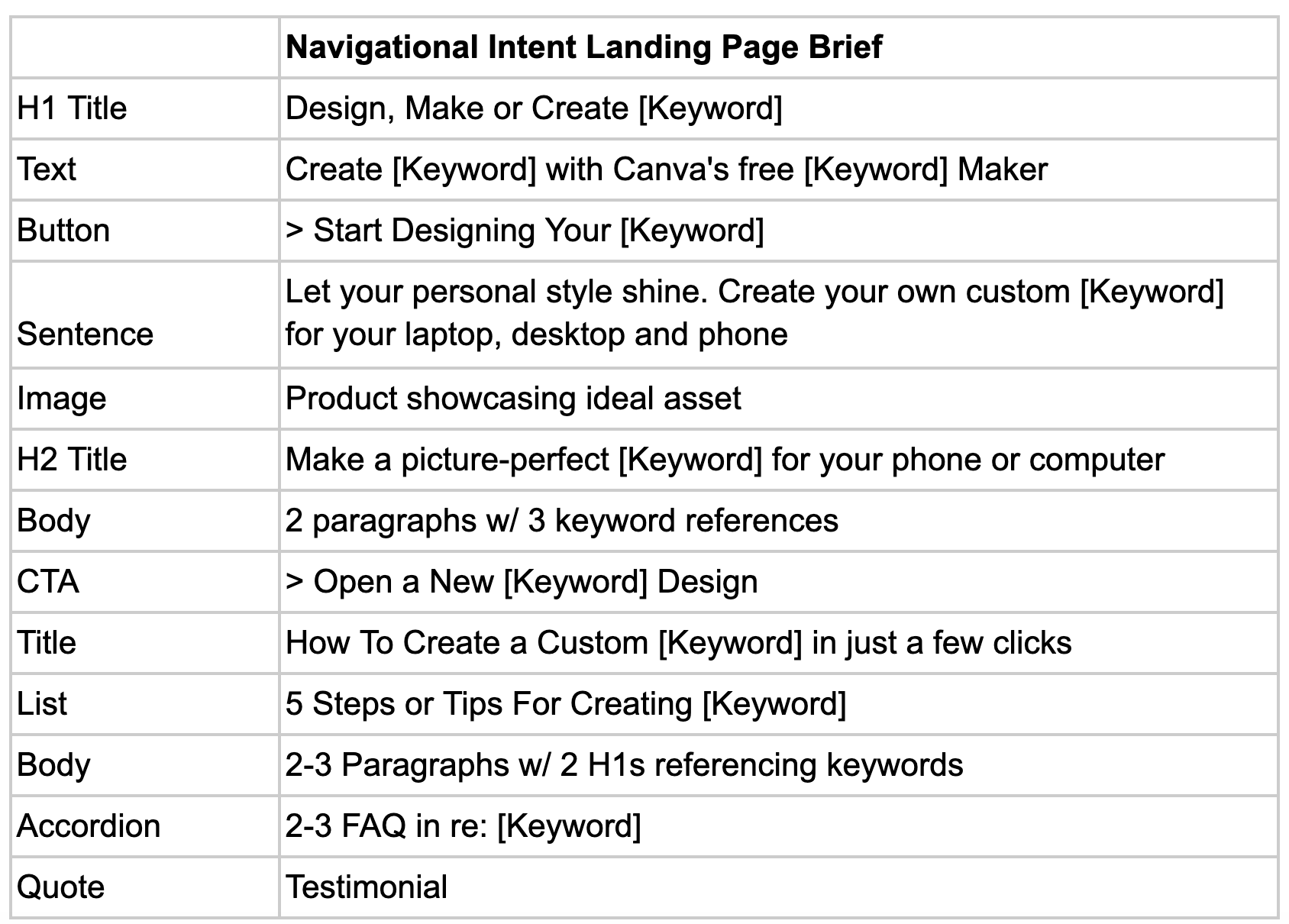
Each section of the landing page has intent. From the H1 that clearly communicates the value of the page while using keywords, to the list that further “educates” the readers and offers additional value, the content is developed for both SEO and conversion.
The approach has worked so well that Canva’s competitor Adobe Spark has followed suit:
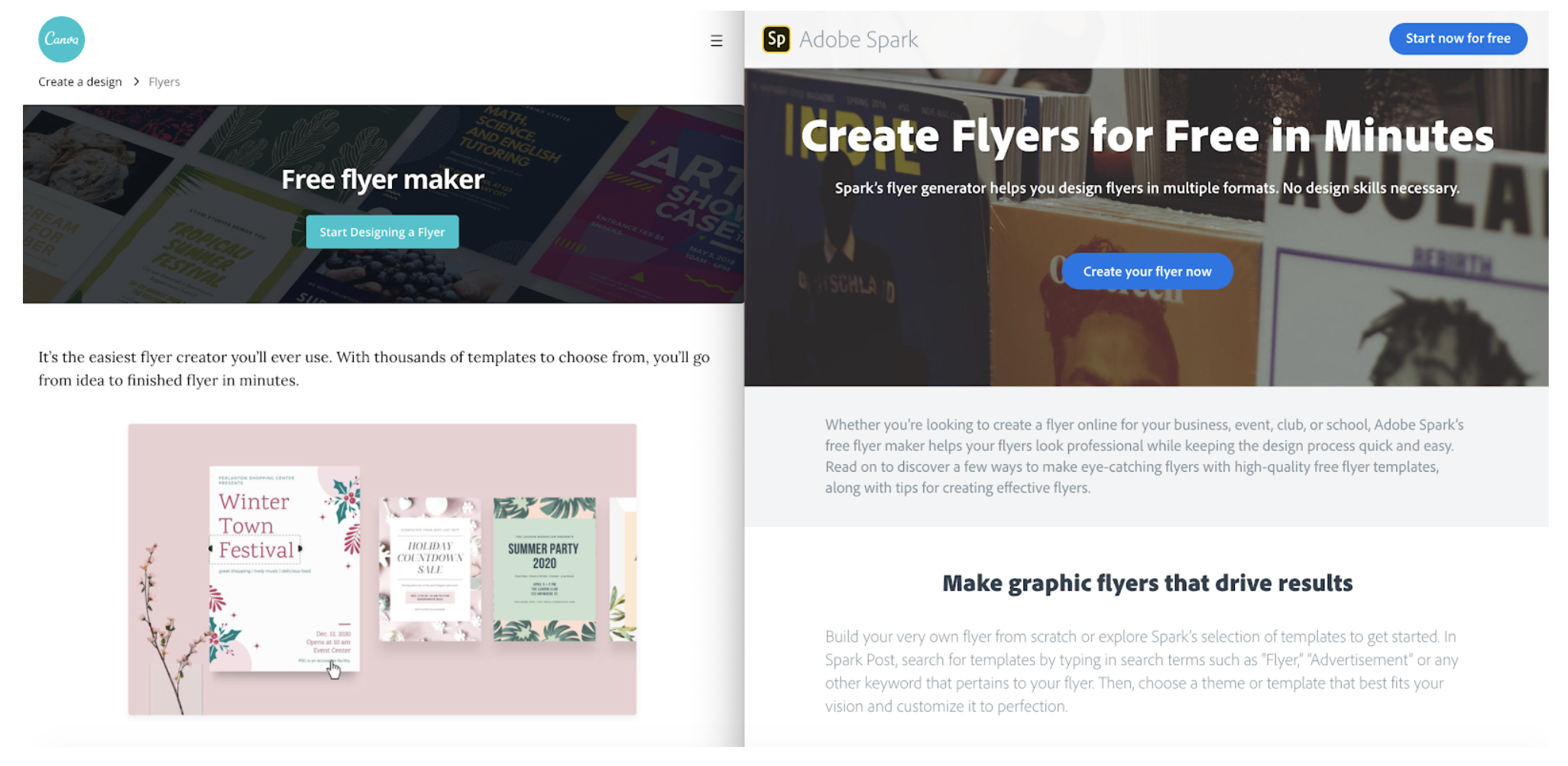
You know the saying:
Great artists don’t copy … they steal.
Invest In Personalized Backlink Outreach
Getting backlinks doesn’t happen overnight.
It’s a process that requires long-term investment if you want it to pay dividends in organic traffic. The landing pages created by Canva to rank for transactional queries like “infographic maker” or “certificate templates” haven’t picked up all those backlinks by chance. Canva has intentionally invested in these pages to capture backlinks from third parties such as bloggers and journalists.
Canva has developed a team of outreach specialists who identify content that mentions things like “invitations,” “posters” or “digital marketing tools.” Then they reach out to the creators.
Here’s an email that Canva sent to a blog owner back in 2016:
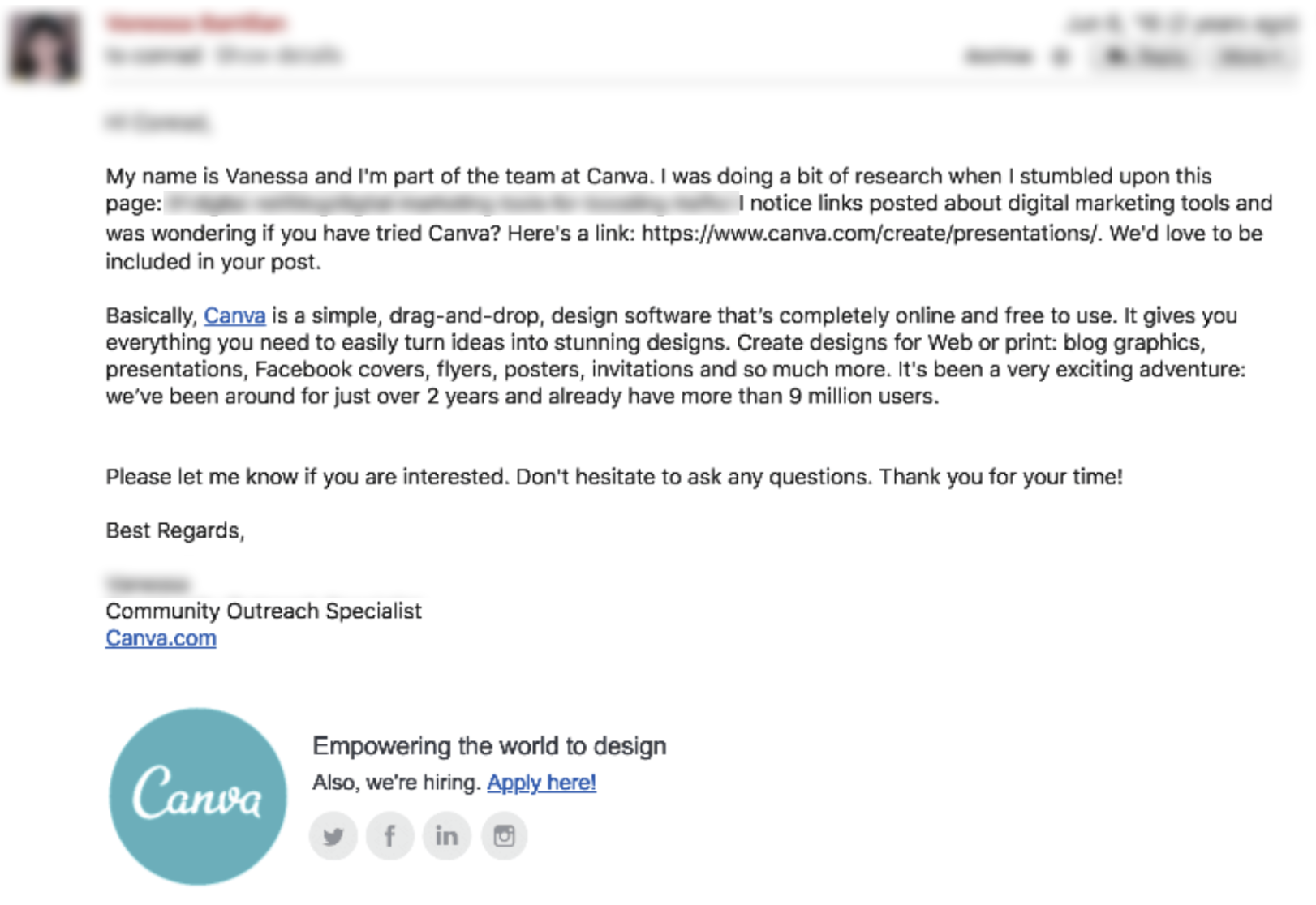
And here’s one that I received while writing this post (2020):
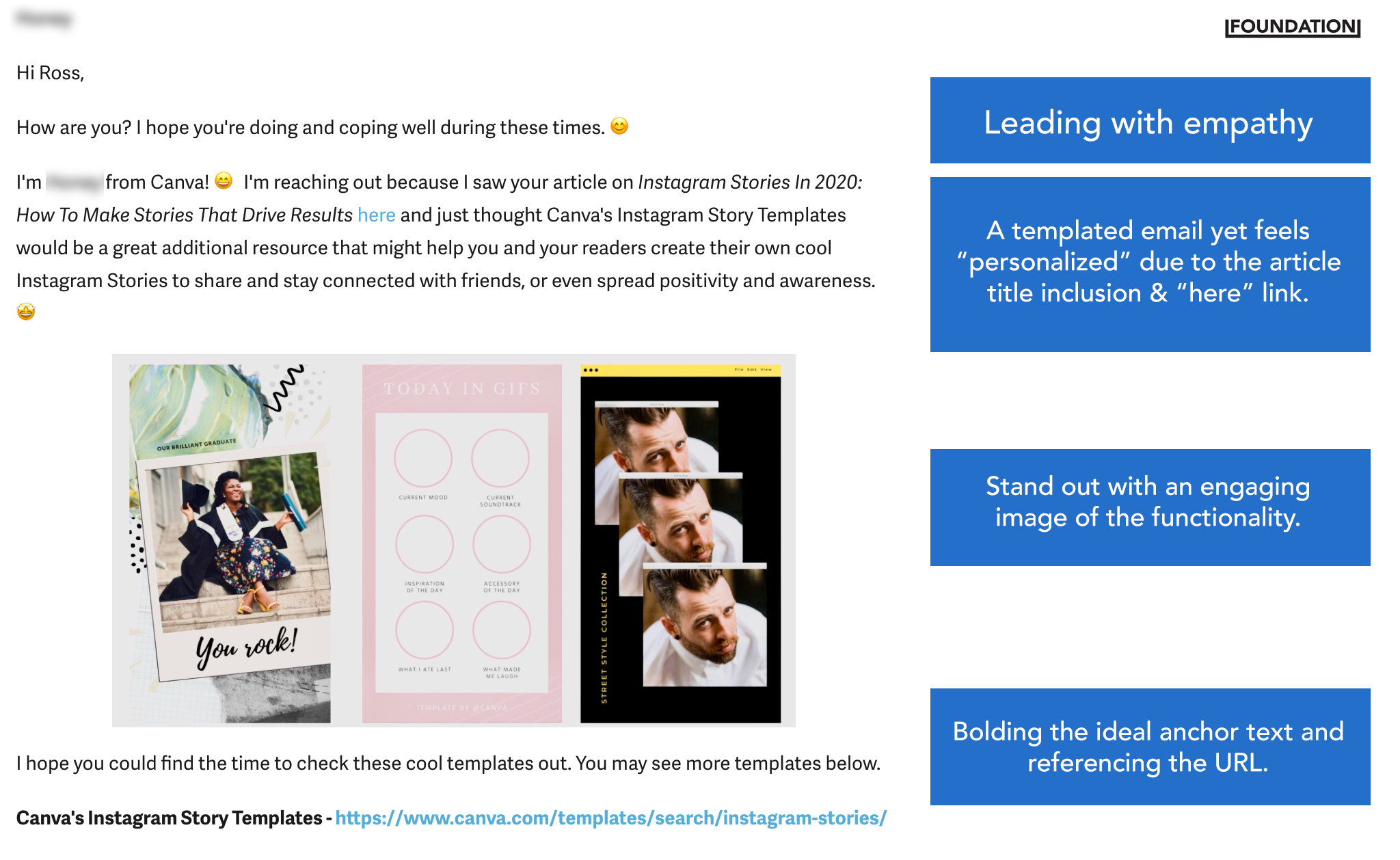
A few things to note that Canva did right with this outreach (in the midst of COVID-19):
- Leading with an empathetic message
- Including the name of my article in the email
- Saying “here” and linking the URL vs. showing the full URL
- Using an image to stand out from most emails
- Bolding the ideal anchor text (inception)
For the last five years (maybe more), Canva has been investing in backlink outreach and as a result they’ve seen some massive growth.
Today, they have more than 4.24M backlinks from 100,000 domains and generate more than 270 million visitors every single year from organic traffic alone. This doesn’t include their ongoing investment in paid traffic as they go after high intent and highly competitive keywords.
Here’s a snapshot of how their backlinks have grown over time:

How does Canva do it?
The most important part is investing in a strong content culture. And a strong content culture requires a strong team.
The content marketing team needs to consist of great leaders / managers, developers, specialists (outreach) and creators (writers and optimizers).
Canva has invested heavily in staffing and building a marketing engine that prioritizes SEO. Today, more than 75 people are listed as working at Canva (part time or full time) with SEO in their title or job description. In particular, the individuals behind the brand’s explosive backlink efforts are called “SEO specialists,” and they span the globe, with team members in the Philippines, Indonesia, Estonia, London, Kyiv, Australia and more.
We found a recent job posting from Canva for a SEO Outreach Specialist:

The job description for this role includes:
- Identify high authority quality blogs & sites to reach out to through our outreach process
- Analyse competitors & find out new link opportunities
- Maintain link diversity
- Meet monthly minimum target
- Send weekly & monthly reports to the team
- Have fun and enjoy working with our amazing international team!
Two things stand out in this job listing:
- They reference an already established outreach process
- Their SEO specialists are given a quota just like a salesperson
Based on this description, it seems like the SEO specialists are responsible for end-to-end link building, from discovering opportunities to closing those opportunities and reporting on them. The minimum quota is likely in terms of volume of links per month, and it very likely comes with criteria for link quality. I’ve heard that in some organizations, outreach professionals are also incentivized with bonuses for exceeding monthly link quota or for being the highest performer on the team when considering cumulative domain authority.
While it’s very possible that Canva’s SEO team has swapped out tools since 2016, the original marketing stack consisted of SEMrush, Ahrefs, Mixpanel, Heap Analytics, Google Analytics, Mention and BuzzSumo (according to an AMA on Inbound.org).
Let’s look at how this strong content culture helped Canva continue to grow its backlink empire even during the pandemic.
Create Landing Pages In Response To New Demand
The rise of remote work around the world led to a massive increase in the adoption of Zoom.
Teleconferencing software was one of the most popular SaaS industries during the initial wave of COVID-19. At first glance, it doesn’t seem like Canva would benefit much from the rise of telecommuting and remote work—but they did. The increased demand for Zoom resulted in the increased demand for custom Zoom backgrounds.
Take a look at this Google Trends track for the query “Zoom Background”:

When demand spiked, Canva reacted.
They developed a new vertical dedicated to Zoom backgrounds. The landing page for “Customizable Zoom Backgrounds” has 351 backlinks (60% “Do Follow”) from 154 domains. At the end of March, this landing page didn’t exist. Since launch, it’s averaged 15 new backlinks per week. In the same Zoom Backgrounds category, the landing page “Create a Zoom Background” has 298 backlinks from 132 domains.
These assets didn’t exist until the end of March.
Yet they have already started to rise in the rankings…
How?
The first step was to stir up as much buzz as possible. They launched the feature on Product Hunt:
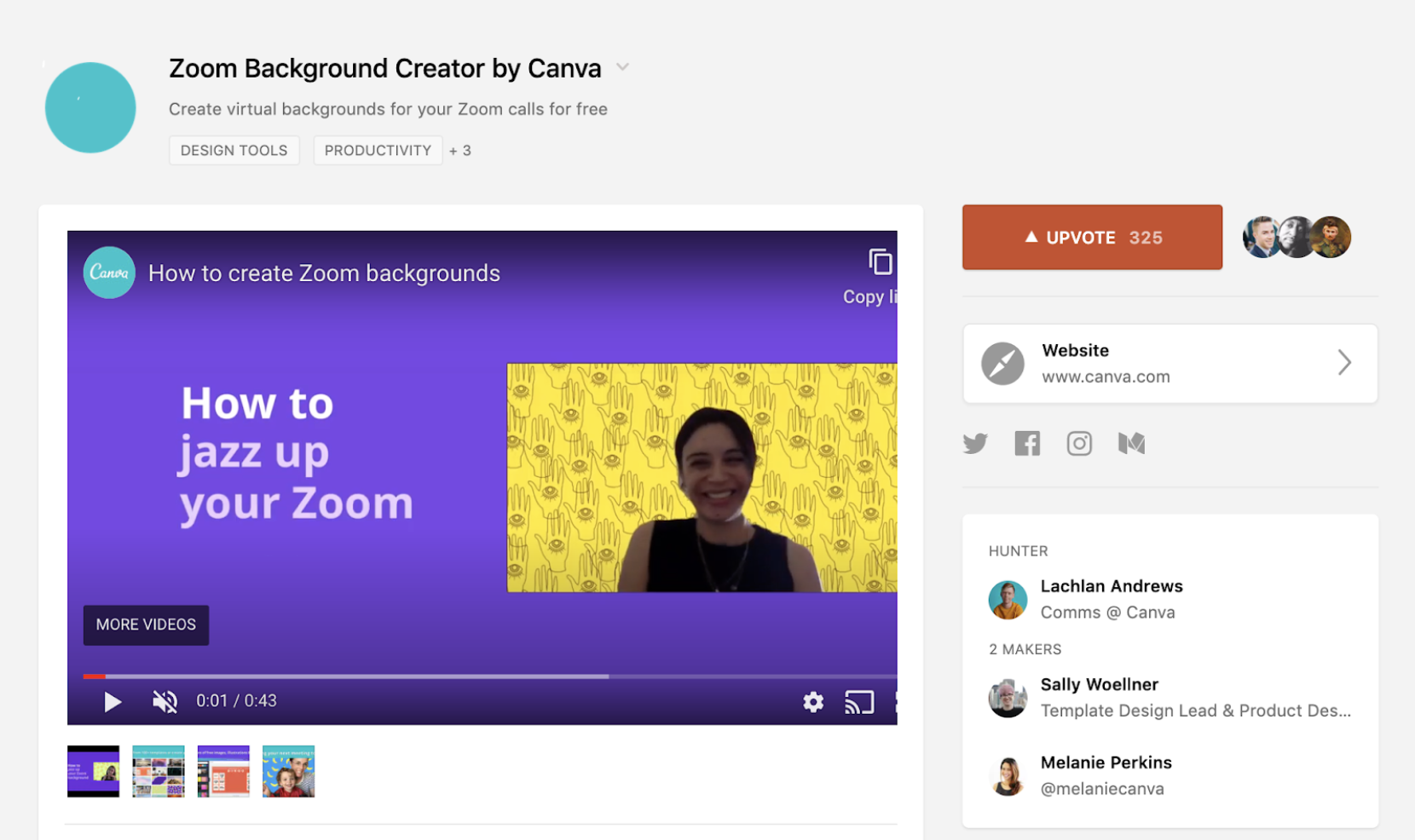
If you’re not familiar with Product Hunt, it’s a site where people share their favorite products, and other folks discuss them and upvote the products they believe are good. The Zoom background maker garnered over 300 upvotes on Product Hunt, but the teaser video promoting the asset currently boasts an impressive 29,362 views and 154 thumbs up. In just the first seven days of publishing, the Zoom video hit 13,000+ views:
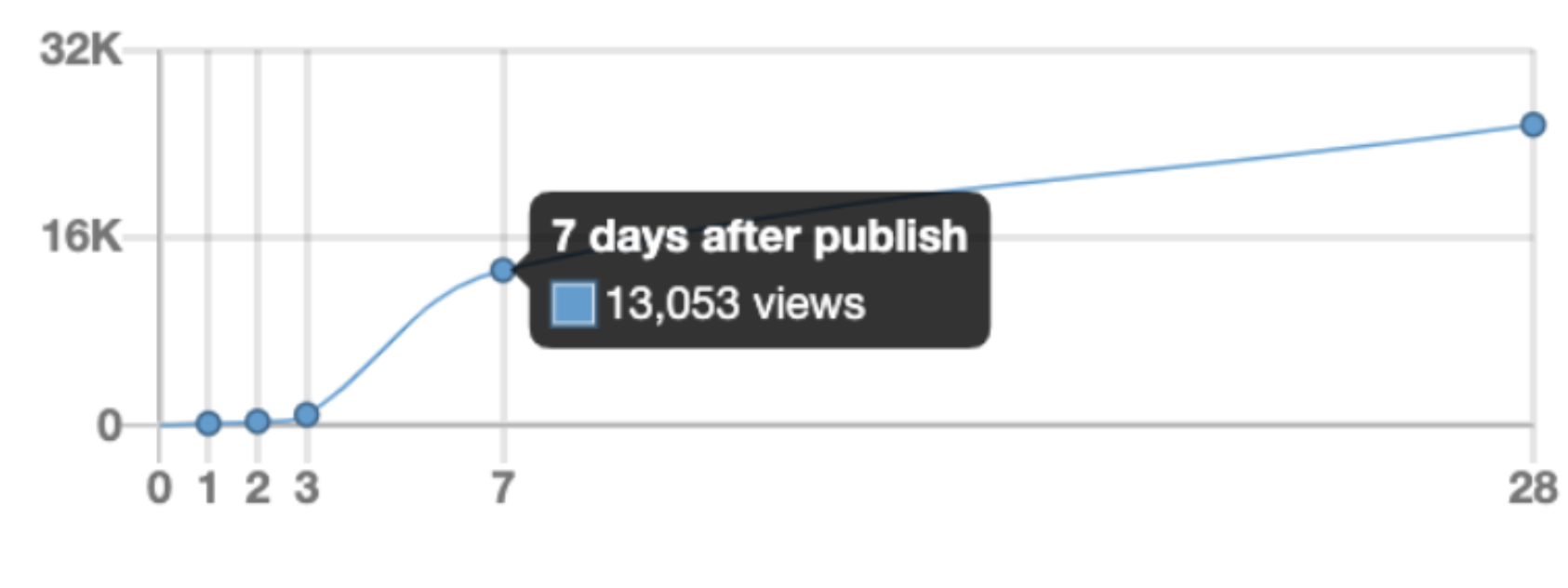
That’s how you launch a new feature.
In the last 30 days, the asset has generated over 150 referring domains.
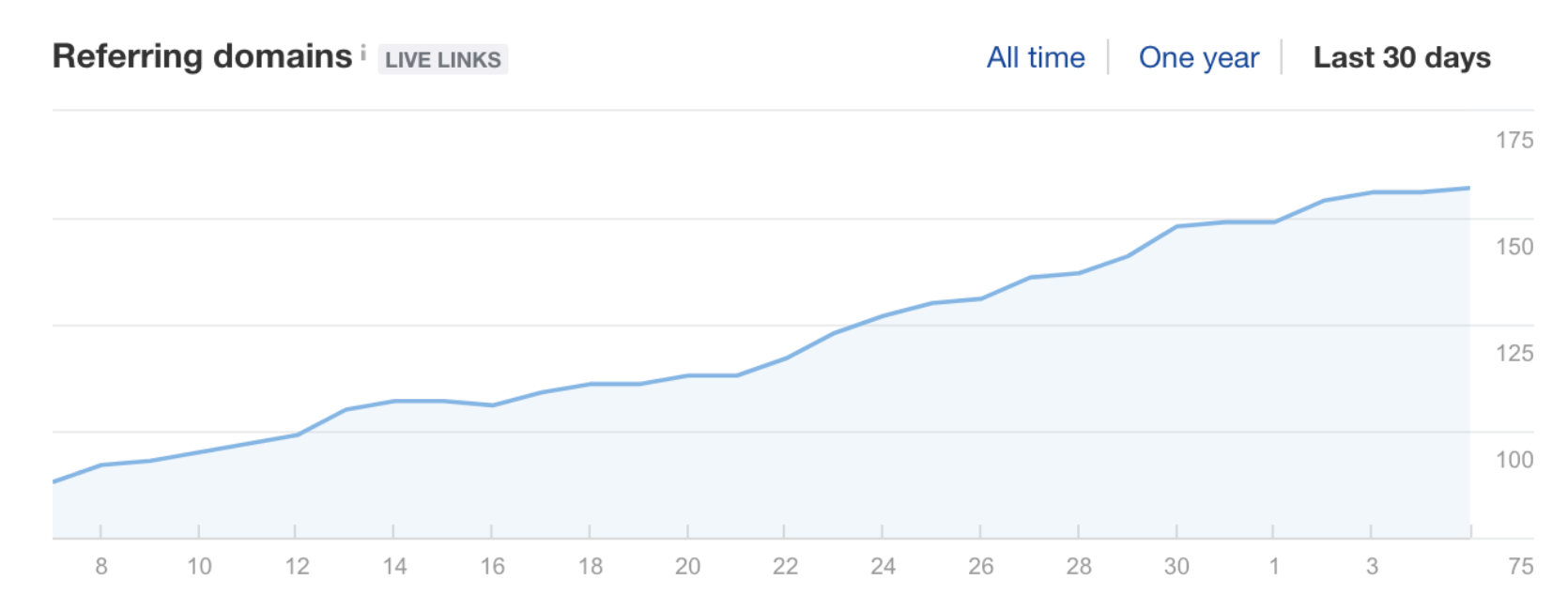
It’s been featured and linked to on AmericanExpress.com, Today.com, The Sun, Gizmodo, Salesforce.org and much more. This isn’t by accident.
This is because Canva has contacted publications talking about topics like “How to work from home in 2020” and has been able to get links to the appropriate assets with ideal anchor text.
Leveraging Blog Content To Drive More Results
After launching their Zoom background asset on Product Hunt, Canva wasn’t done promoting the new feature.
Historically, the brand has generated a significant amount of traffic through their blog. In 2015, the former head of growth at Canva wrote about the techniques that helped them increase blog traffic by 226.47% in 60 days:
- Longer posts
- Inspirational posts like “50 best business cards”
- Varied content types—lists, feature articles, interviews, etc.
- Free resources
- Proactive list building
Here’s a screenshot of their growth after implementing this strategy:

The fundamentals of this strategy are still used today.
Canva recognizes the power of their blog as not just a vehicle for traffic but as an educational resource and lead generation tool. The team developed two blog posts that went after highly searched terms and further promoted their new feature, while embracing the formula that has worked since 2015.
The posts were titled:
- How to use Zoom virtual backgrounds (1,790 words)
- Funny zoom backgrounds that will have you laughing (1,051 words)
These two blog posts are strategically developed not only to rank but also to convert. In the how-to post, the phrase “Zoom virtual background” shows up 15 times in the title, H1s, H2s and body content. In the inspirational post, the phrase “Zoom background” shows up 7 times in the title, meta description, H1s and H2s.
Throughout the blog posts there are calls-to-action directing the reader to the various templates that are shown. Here’s how the templates are promoted throughout the inspirational blog post.

The blog posts link back to the original landing pages with the perfect anchor text: Zoom virtual background. But what’s most interesting is the new backlinks that have been generated by these two blog posts. In just 30 days, these blog posts have 58 links and are rising in the SERP for their target keywords.
Missing Opportunity: Comparison Pages (Investigation Intent)
Now… despite all the things that Canva is doing right, there’s one area in which they’re missing out. They’ve done a great job of creating content to meet every kind of search intent—except one: They don’t have any content to capture traffic when someone does a comparative search.
Take the search “Canva vs. Adobe Spark” as an example. This phrase has more than 450 searches a month, and it’s safe to assume they’re coming from people who are really close to making a decision between the two platforms:

The first three articles ranking for this query are not from Adobe Spark OR Canva. Creating a landing page that targets these keywords would allow either brand to own the narrative when someone lands on this SERP looking for answers. It’s my expectation that if neither of these brands capitalizes on this search volume, the various online review sites leading the way in the Yelpification of B2B will eventually start to show their head.
The Google autocomplete suggestions clarify the opportunity here:
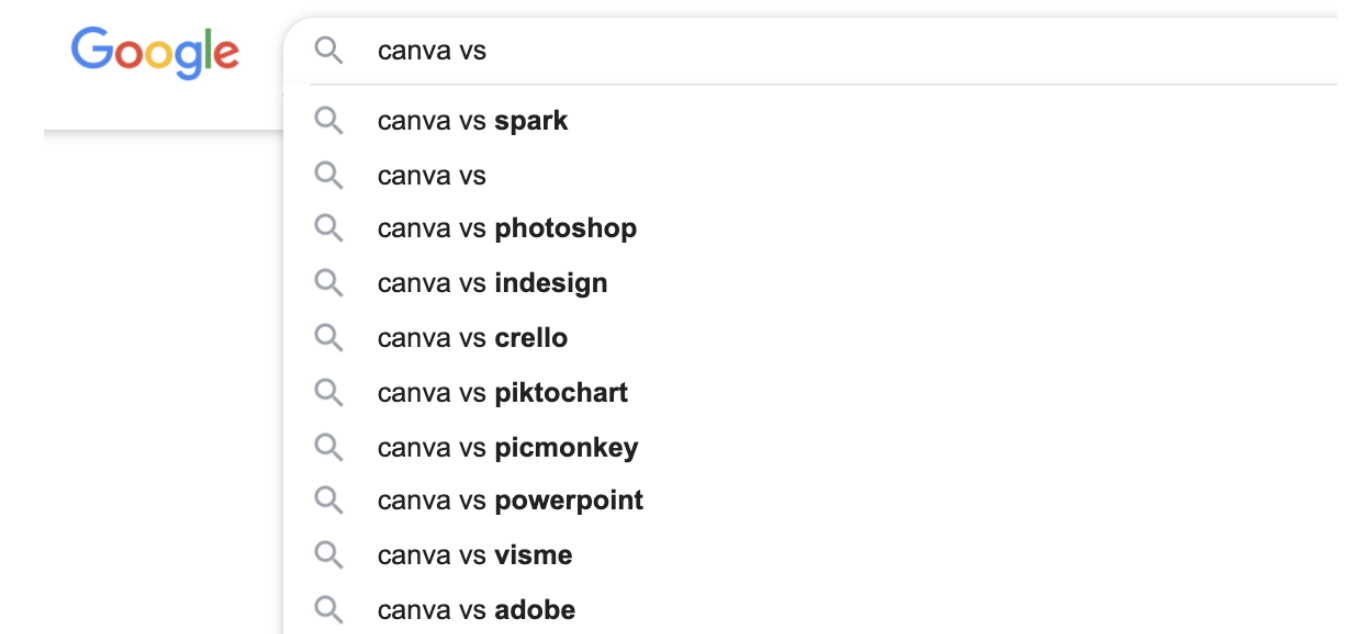
Comparison landing pages can be a great way to connect with people at the bottom of your funnel and capture leads for remarketing purposes. It’s at this point in the buying process where someone is typically deciding between you and your competitor. The development of an asset that can influence that individual in the direction of your brand is a smart way to capture value.
Wrapping This All Up
It’s impossible for any marketer to read this essay and in 48 hours unlock results similar to Canva’s. It takes time to build a backlink empire and create a sustainable series of landing pages that work for you long after they’ve been developed. It takes time to write job descriptions, create training, develop a compensation model and onboard a group of outreach specialists and experts. It’s impressive to see what Canva has accomplished.
And while it’s certainly not going to be easy for any brand to replicate their success, it’s certainly possible to look at Canva for inspiration moving forward. The best organizations will recognize that it all comes down to creating a culture that understands and truly believes that content is a key factor in driving success.
If you’re a company or marketer that wants to accomplish similar feats, we’ve developed a B2B Growth Strategy Guide that is sure to help. Check it out and use these strategies to fuel growth in your organization for years to come:








